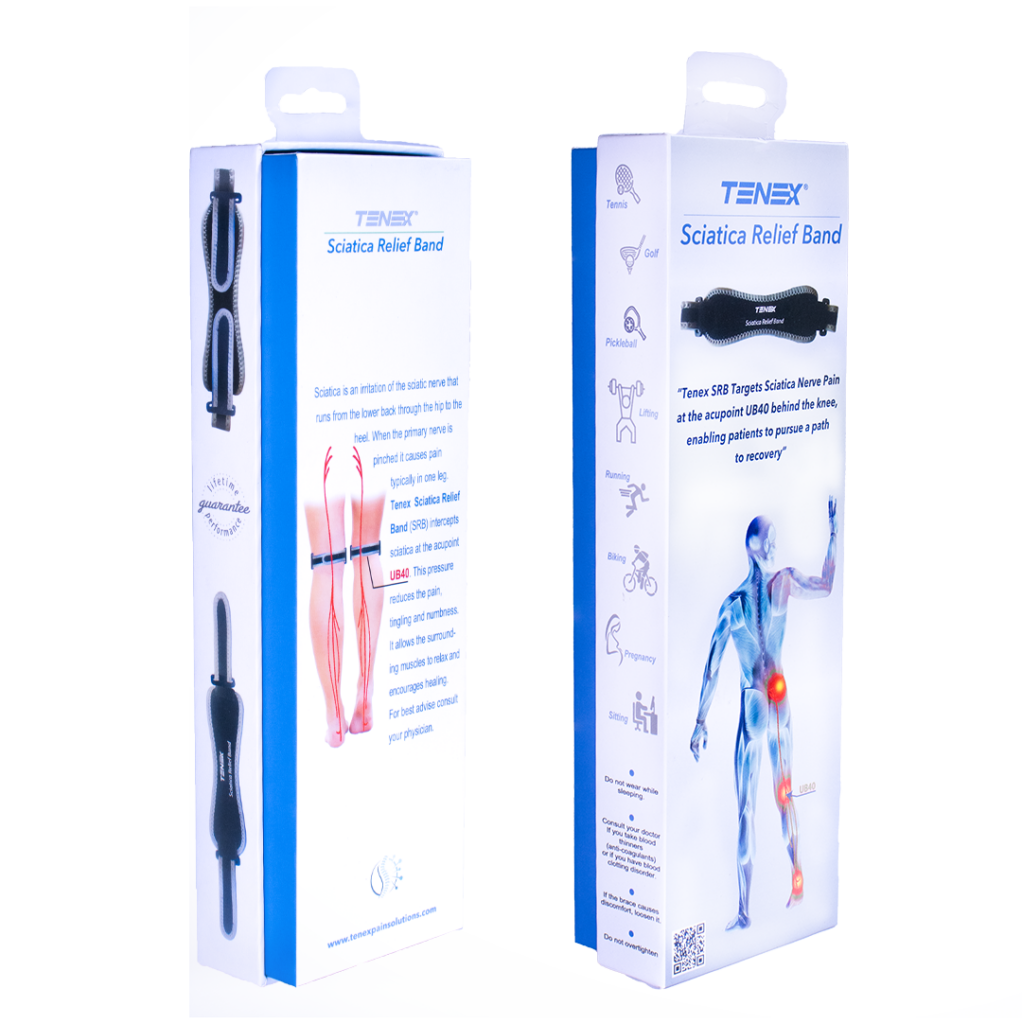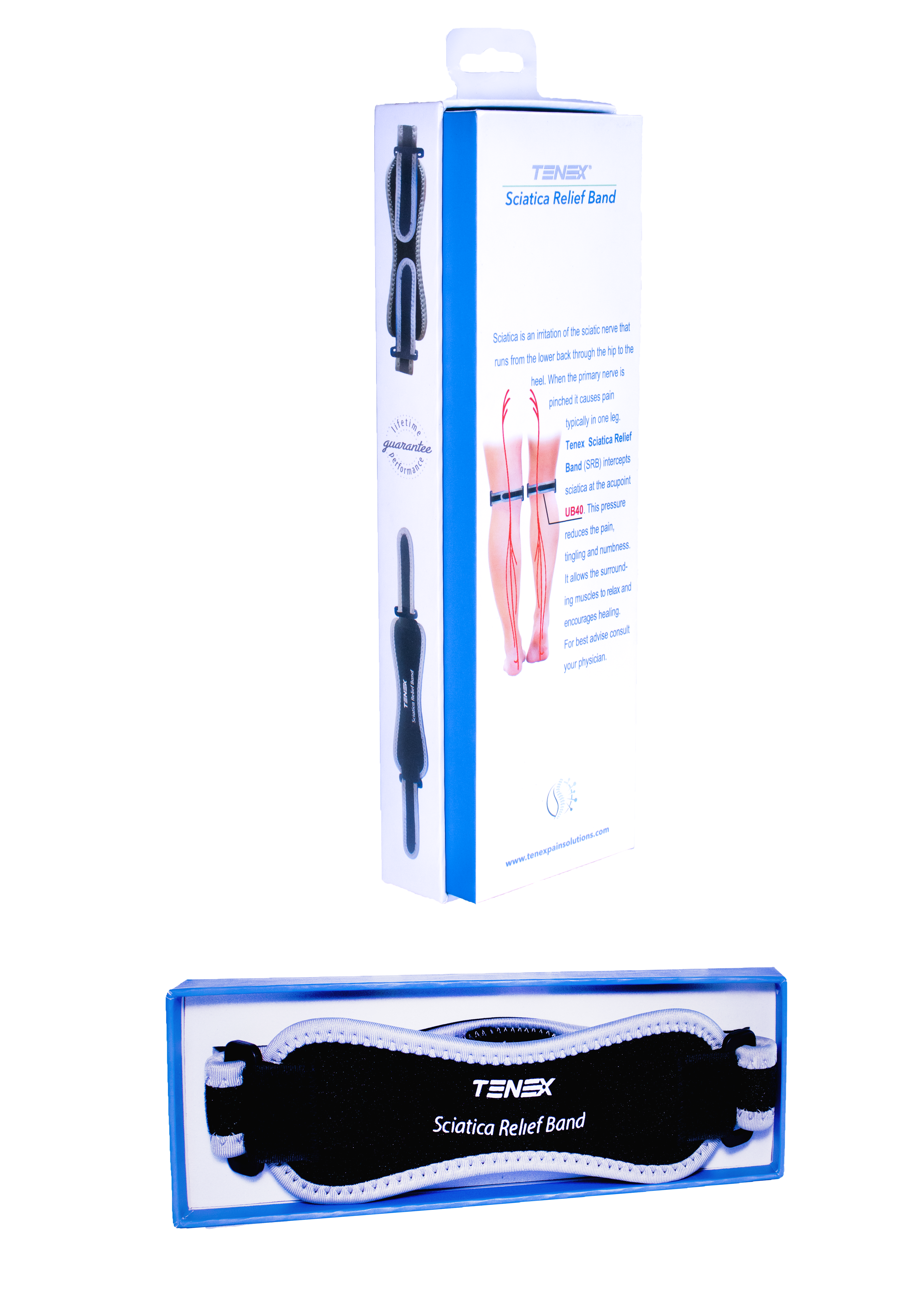
$34.95 Original price was: $34.95.$19.95Current price is: $19.95.
Running from the lower back through the hip and leg to the heel, the sciatic nerve supports the motor and sensory functions in your legs. When the nerve is pinched it causes pain-typically in one leg. TENEX SRB intercepts sciatica pain at an acupressure point behind the knee called UB40. Unlike surface braces or socks, it gets deep enough to engage the nerve altering the brain’s pain signal and allowing the surrounding muscles to relax.
Technical Specs:

When strapped around the knee so the half-sphere is facing in behind the knee, TENEX SRB applies acupressure to sciatic acupoint UB40, interrupting the painful nerve flow and energizing the surrounding tissues.
Acupressure points are the same as acupuncture points or simply acupoints. UB40, or Bladder 40, is an acupoint that was identified thousands of years ago as a location in a body’s nervous system that could be massaged to relieve sciatic and knee pain. This is true for both humans and animals like horses and dogs. For humans, UB40 is located on the middle point directly behind the kneecap on the back of each leg.
TENEX SRB is proven to reduce sciatic nerve leg pain by as much as 70% in one hour. This reduction in pain can help people increase their level of physical activity and greenlight a PT program to address behavioral and source issues to effect a lasting cure.
Sciatica pain causes range from injury and disease to pregnancy. But sciatica or sciatic nerve pain is NOT a diagnosis. Not all sciatica is caused by sciatic nerve problems.
Sciatica CAN be caused by pressure on your sciatic nerve, but it can be caused by:
But sciatica can also be caused by:
Most often sciatica is caused by a combination of many of the factors above – both sciatic nerve pain in addition to muscle and/or joint pain. How YOUR sciatica is caused is crucial to deciding what needs to be done to relieve YOUR sciatic nerve pain.
Our methodology is to analyze the possible causes, reduce your pain to get you moving and create a program to help you mitigate and eliminate the pain in the future.
There are four basic types of sciatic nerve pain: acute, chronic, alternating, and bilateral.
Acute sciatic nerve pain can run the gamut, from “sharp, achy pain” to “numbness” to “burning, tingling” to “weakness”. In the case of acute pain, it can be brought on by any sudden irritation to any of the nerves or a combination of all of them. The nerves quickly become pinched or compressed, which causes immediate, and short-term, pain.
Chronic sciatic nerve pain is categorized by its longer duration – typically continuous pain for two months or more.
While sciatic nerve pain nearly always takes place in only one leg, occasionally it shows up as bilateral pain, meaning that it’s experienced in both legs.
Although some people may have sciatic nerve pain in one leg or both, a select few will experience alternating pain, or pain that’s felt in the right leg or the left leg, and it can switch sides.
Usually, sciatica affects only one leg at a time and the symptoms radiate from the lower back or buttock to the thigh and down the leg. Sciatica may cause pain in the front, back, and/or sides of the thigh and leg making it difficult to walk. A few common symptoms seen in sciatica:
Sciatica pain may be constant or intermittent. The pain is usually described as a burning sensation or a sharp, shooting pain and is usually more severe in the leg compared to the back. Leg pain commonly occurs more in the calf region below the knee compared to other parts of the leg. Numbness, tingling, and/or a pins-and-needles sensation may be felt at the back of the leg. Weakness may be felt in the leg and foot. A feeling of heaviness in the affected leg may make it difficult to lift the foot off the floor. Sciatica pain may feel worse while sitting, trying to stand up, standing for a long time, bending the spine forward, twisting the spine, and/or while coughing. Change in posture may aggravate or relieve pain.
Pain may increase or remain constant while laying down, causing disturbed sleep. There may be other sciatica symptoms that are specific to the affected nerve root.
A general guideline to follow is that you should start by wearing the SRB for an hour with pressure firm enough so that it hurts a little. The more developed the muscles are, the more pressure you should apply. If you feel extreme sensitivity or pain, gradually decrease the pressure until you find a balance between pain and pleasure. Do not continue to press a point that is excruciatingly painful. Once you begin to find some relief, extend the amount of time you wear the SRB, up to about 4 hours in a passive setting. Regulate acupressure duration going forward based on your results and time available.
Just tighten or loosen the elastic band and re-position the half-sphere onto the UB40 spot.